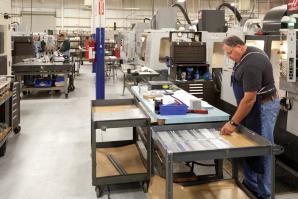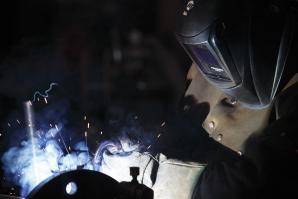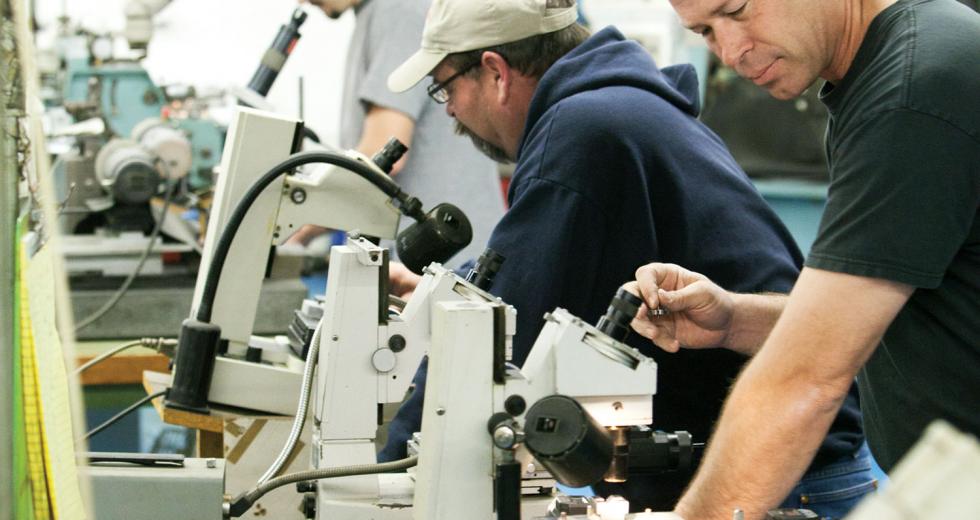If a local economy is thriving and healthy, it may have the manufacturing industry to thank. If things aren’t so good, it’s probably because manufacturing jobs are leaving.
Manufacturers buy parts and services from local businesses then export their products, thus bringing money to the community. They also provide good benefits to well-paid employees who spend their paychecks at local shops, restaurants and housing developments.
“If you look at industries across the board, manufacturing has one of the highest economic impacts on a community,” says David Snyder, Placer County economic development director. “It comes down to them being a big bang for the buck.”
That’s why business and government leaders in Placer County — where manufacturing employs about 8,000 people and makes up about 10 percent of the economy — are banding together to boost this vital industry.
A centerpiece of the effort is restoring the Placer County Manufacturers’ Association, which started in the early 1980s with about 25 companies but fizzled in the late 1990s. The revitalized organization could bring clout, networking opportunities and power in numbers to an industry that has showed alarming declines the past decade.
The state has lost hundreds of thousands of manufacturing jobs, according to Snyder, and the county around 2,000 over the past 10 years. The county’s manufacturing jobs have declined about 9 percent since 2003, compared to 7.5 percent statewide and nationally. Since 1998, the decline has been 14 percent in Placer County compared to 23 percent statewide and nationally.
Regionally, things haven’t looked much better. A report by the Center for Strategic Economic Research showed the Sacramento area losing 13,000 manufacturing jobs from January â?¨2001 to May 2010. “The main manufacturer we’ve lost in the five years I’ve been in this position is Formica Corp.,” Snyder says. The company manufactured high-pressure laminates and solid surface materials and employed about 350 workers. The top-25 manufacturer in the region announced its closure in May 2006 as part of a nationwide consolidation.
Manufacturing has followed the same ups and downs as the overall economy, but the peaks and valleys were far more pronounced, especially in Placer County. According to the Center for Strategic Economic Research, 55.7 percent of the county’s manufacturing industry in 2008 created computer and electronic products. Wood products at 8.1 percent were a distant second, and machinery came in third at 7.6 percent.
The county’s top manufacturers and number of employees include: Hewlett-Packard Co., 3,000; Pride Industries, 2,000; Sierra Pacific Industries, 300; SierraPine, 200; Pasco, 200; Gladding McBean, 100; RobbJack Corp., 100; Greenheck Fan Corp., 100; and Harris & Bruno International, 100.
It was manufacturing heavyweight Hewlett-Packard that was a key force in starting the original Placer County Manufacturers Association, says county Supervisor Robert Weygandt, who has been a strong supporter of the group’s renewal.
“The goal was having an organization that could share information and participate in local community affairs, so they could be more proactive and constructive in that process instead â?¨of just sitting on the sidelines and seeing what might happen to them, Weygandt says.
“It was based largely on HP’s experience down in the Bay Area when the Silicon Valley exploded, particularly with regards to things like transportation planning and land-use planning,” he continues. “They â?¨realized they could have — and should have — done a much better job in helping find solutions that were more business friendly.”
The original association thrived for several years, then dissolved due to a combination of factors, Weygandt says. Several key participating companies left Placer, including Herman Miller Inc., Formica Corp. and Reynolds Aluminum. NEC and Hewlett-Packard downsized.
“So that obviously just took some energy out of the organization,” Weygandt says.
About a year ago Weygandt and Snyder met with Dave Baker, president of RobbJack and the manufacturing industry representative on the Placer County Economic Development Board. They discussed rekindling the association; a subcommittee was formed to explore the idea and has met several times.
But before anybody could proceed, instigators needed to know if the manufacturing community would get behind the effort.
In October, 125 government and business leaders convened for a daylong forum at Renesas Electronics Corp.’s manufacturing plant in Roseville on how to grow manufacturing in Placer County.
They came away with several general conclusions, among them that manufacturers need fewer regulations and taxes to thrive as well as more innovation, and that more energy should be spent on attracting small manufacturers and suppliers to manufacturers, so companies will know they have quick and easy access to the equipment they need.
“If you look at industries across the board, manufacturing has one of the highest economic impacts on a community.”
David Snyder, economic development director, Placer County
A survey of meeting participants showed they strongly supported restoring an association and were willing to be active participants.
In a follow-up meeting in March, Yuba-Sutter Manufacturing Association President Tom Williams and staff member Brynda Stranix talked about their association and how it has benefited the industry. The Manufacturer’s Industrial Distribution Roundtable of the Greater Stockton Chamber of Commerce and the Manufacturer’s Council of the Central Valley (headquartered in Modesto) were also discussed.
The manufacturers present agreed to create a Placer County Manufacturing Report (similar to the county’s agriculture crop report). It would be compiled over the coming months and used as a tool to influence public policy.
“It would give information on how many dollars of goods we’re selling locally and nationally, how many people we’re employing, how many dollars we’re paying those people and estimates on how many times the dollars are turned over in Placer County before they leave,” Baker says.
Participants also agreed to hold a Second Annual Manufacturer’s Forum in October 2011, where they could share results of the report, programs and resources as well as network.
Baker, whose company has been in Placer County more than 20 years, says one of the priorities of a new association would be working to make government an asset rather than a liability in attracting and keeping good companies and jobs.
“Businesses like mine have an issue at times with regulations, permit processes and cooperation from local government,” Baker says. High state taxes don’t help either, he adds.
He says that while his company has had a good relationship with the city of Lincoln, he hears from colleagues in other cities that “sometimes it’s just too difficult to get what they need to get done in a timely manner.”
He says he’s grateful for the government allies, such as Snyder and Weygandt, he’s found in striving to boost his industry. “In fact all of the supervisors have been very supportive,” he says.
Weygandt says his support came naturally. Formerly in manufacturing himself, he still lives on the small Placer farm where he grew up. “I’ve been on the Board of Supervisors for 16 years and have always had a passion for economic development and trying to create a condition where government’s policies are as friendly as possible for helping to create and sustain primary wage earner jobs that have retirement and medical insurance benefits,” Weygandt says.
This begins, says the conservative-leaning supervisor, not so much with political ideology as government simply doing its job well. “At the local level we can do quite a bit to make sure our government services are delivered as efficiently as possible, that we can do good planning for infrastructure, and, within reason, we can even market our community to prospective companies and sit down and talk with them when they’re here about some of their issues and problems,” he says.
Supporting the reinstatement of the manufacturers’ association is a good start, he says. But it’s not government’s responsibility to boost the industry, all involved agree.
“We in business think we can do things to promote Placer, branding products ‘made in Placer County,’ pooling resources and getting Sierra College to train and help us hire future workers,” Baker says.
Better communication with one another is key, he says. “We want to make sure that all the manufacturers in the area are aware that there are benefits to be had, and some of them are partially funded by the county and the federal government. And then we’d like to share best practices on the payroll, safety, environmental compliance and things like that.”
Snyder notes that some manufactures he spoke with following the meetings “had been buying an industrial service or a product outside the area because they simply didn’t know that this particular supplier was right within their midst.”
Despite the challenges, Placer leaders are confident they can get the association going and boost the industry.
There are already some encouraging signs. Snyder says manufacturing’s payroll is actually up 2.5 percent since 2003, reflecting gains in productivity and the high-tech nature of the workplace.
Weygandt notes the attributes of Placer County that fit manufacturing companies well. “If companies are just looking for a site that is an inexpensive place to operate, we’re probably not it — but we tend to have very productive people. We have a situation that combines technology folks with the proximity of markets. Some of our companies that we’ve lost stated that their companies here were the most productive than anywhere in the world.”
Recommended For You

The Auburn Advantage
How one city turned lifestyle into business leads
Downtown Auburn has a distinct, modern-day Mayberry feel, from the stone-paved sidewalks to the rustic brick bus stop. But five miles away,

Growth Strategy: Make More Widgets
How manufacturing could bolster the region...eventually
As Sacramento attempts to forge a regional economic development strategy, manufacturing is being touted as a potential breadwinner, but rebuilding the industry piecemeal could take time.



